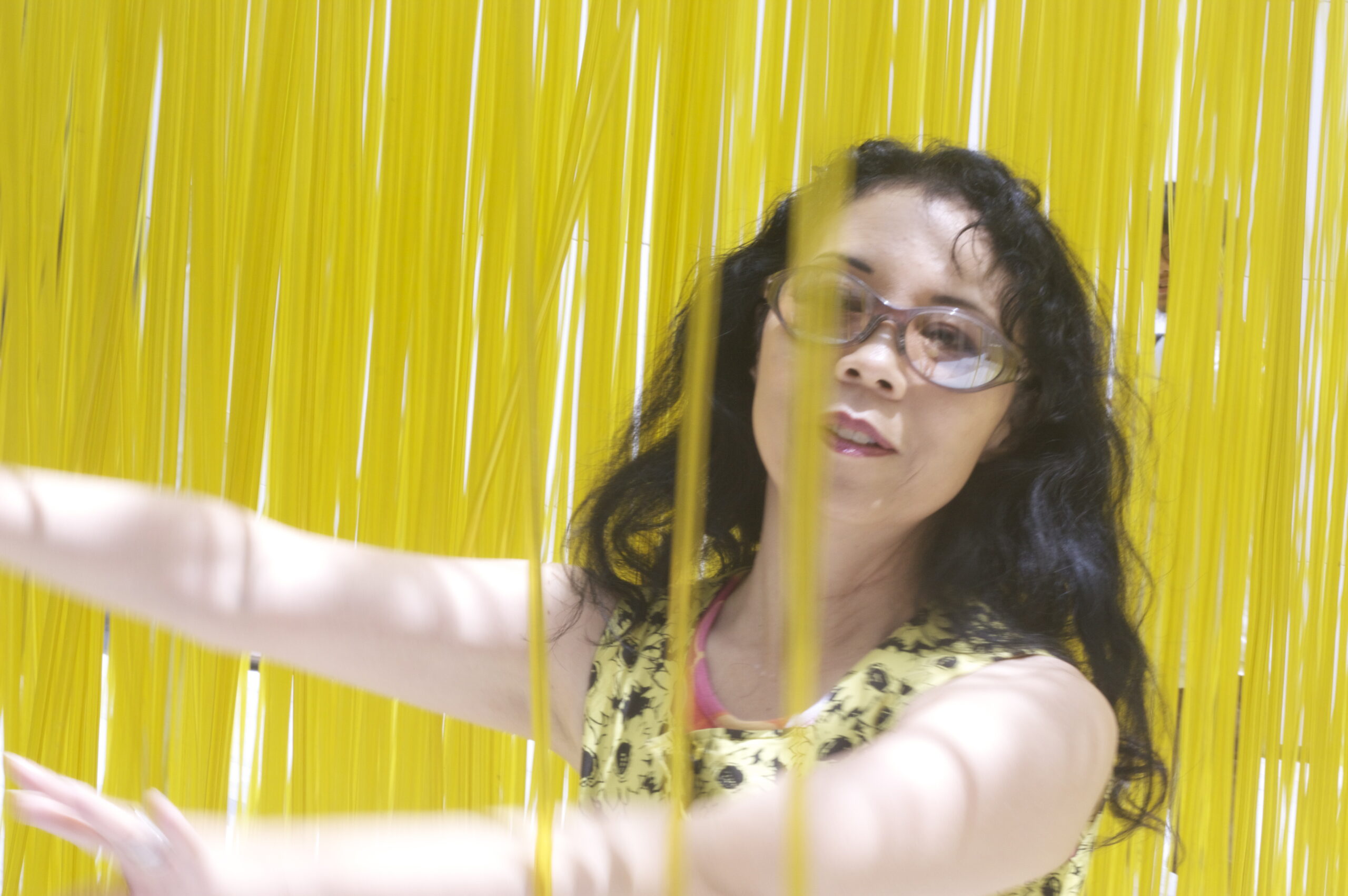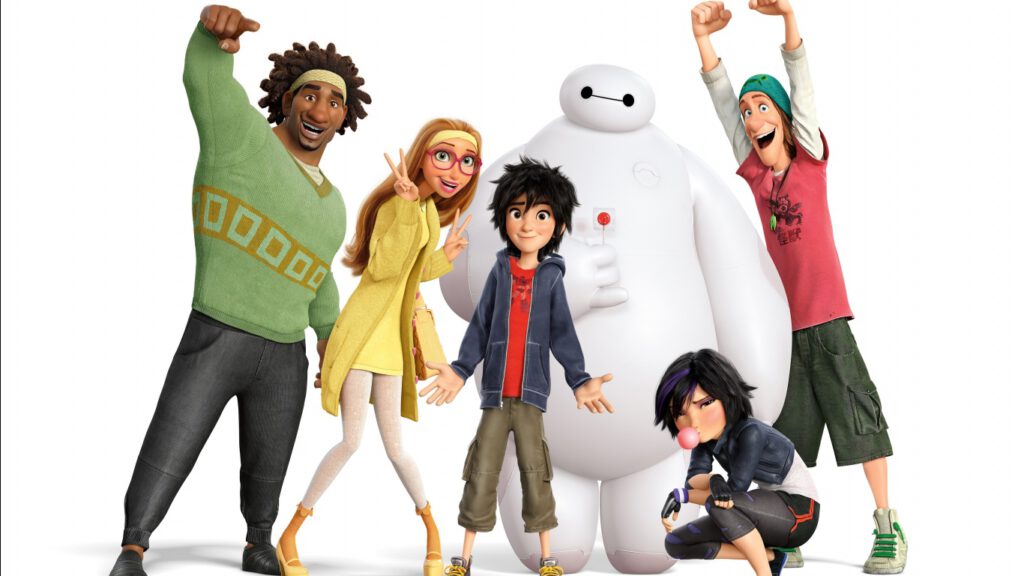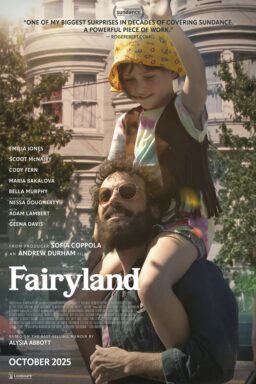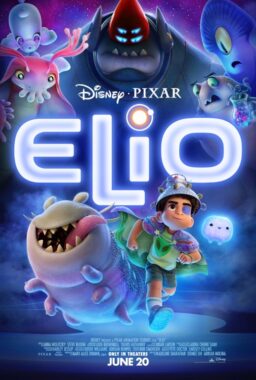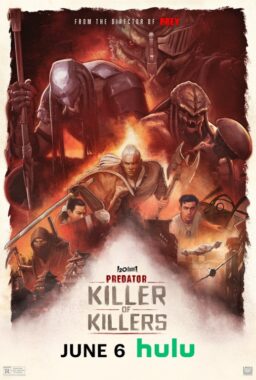What happens when the director of “Winnie the Pooh” (Don Hall) decides to take a Marvel Comics property and turn it into a kid-friendly 3D computer-animated feature? “Big Hero 6” answers that question by straying far enough from the adult-aimed focus of the original comic strip that it becomes part of an alternative universe, one that will not become part of the Marvelverse but is very much a part of the Disney family tradition of cuteness.
Taking place in an alternative universe anyway, a place where Tokyo has merged with San Francisco to become SanFransokyo, the movie embraces the Japanese side of animation and the cultural love for cuteness—the kawaii factor that isn’t limited to squealing young girls. Some Japanese men—and I’m not just talking about metrosexuals—embrace the kawaii factor. Isn’t Disney the company all about the American version of kawaii? There’s no cross-cultural problem here; it’s a match made in heaven that might disappoint only the fans of the original comic book series.
Yet some things are lost in translation.
When Hiro becomes a hero in “Big Hero 6,” it’s a cute homophonic wordplay, but one that borrows from Japanese and slips into English without finding any reciprocal chuckles in Japanese. There might be one if the Japanese knew what Hiro stood for, but that’s one of the difficulties of translations and a reason why some people who, like myself, prefer to see a movie and hear the original voice actors while reading the subtitles.

“Big Hero 6” is renamed “Baymax” (ベイマックス) in Japan, which makes it seem as if the story is about the robot named Baymax instead of Hiro. Hiro is the 14-year-old boy whose brother, Tadashi, created Baymax, who resembles Honda’s ASIMO if the robot had a cousin training for sumo wrestling. He’s not fat, he’s big boned and pleasantly plump and that is played for laughs. Instead of a dark mask for a face like ASIMO or the robot in “Robot & Frank,” Baymax has two dots for eyes.
“Big Hero 6” is an American movie in Japan. At the press screening at Tokyo International Film Festival, we saw the English version with Japanese subtitles. That’s sort of the reverse of what I prefer in the U.S.: Original Japanese voice cast with English subtitles. From the adverts I listened to at the Toho Cinemas, I understand there will be a Japanese dubbed version. I haven’t seen that, but if it follows the subtitled version, there are some things lost and found in translation.
One of the reasons I prefer to hear the original Japanese voice cast is not only because I am somewhat fluent in Japanese and it always is good practice to hear more (I recently learned a few new words from a marathon of watching “Nadia: The Secret of the Blue Water” ふしぎの海のナディア at TIFF), but also because it is a matter of choices made by the original director. When I saw the original version of “My Neighbor Totoro,” the voice of the elderly pipe-smoking woman was gravelly and not smooth and June Cleaver clear as with the English dubbed voice cast. Even with the recent French film, “Ernest & Celestine” (the last performance of the late Lauren Bacall), I preferred the French with English subtitles.
“Big Hero 6”’s most obvious use of homophones in English is lost in Japanese. The English transference of Hiro to hero isn’t there, not only because the Japanese word for hero is eiyū (英雄), but also because even when the English word of hero is used as a direct transfer from English (gairaigo 外来語), the word has two long vowels (Hīrō) and is written in katakana signifying it is a foreign word: ヒーロー。.

That might not mean much in English, but in Japanese long vowel sounds change the meaning of a word. In Japanese, long vowels are more about duration of a vowel sound than a change of the pronunciation. Certainly mistakes and jokes are made about the long vowel sounds such as in the case of ojisan (uncle or middle-aged man) being different from ojīsan (grandfather or elderly man) and obasan (aunt) and obāsan (grandmother). There’s also just a long vowel that separates Mr. Demon (o-nisan) from someone’s older brother (o-nīsan).
The meaning of the name Hiro also isn’t clear in the Japanese version because the name is written in katakana which is usually reserved for foreign words and onomatopoetic words. For this reason, no choice has been made and don’t believe those websites and books which give you a translation for Japanese names such as Hiro and Kenji. Below are examples of what Hiro could mean.
博 aim, rich, plentiful
浩 grand, great, vast
弘 great, liberal
宏 magnificent, spacious
In the case of the elder brother, the name Tadashi instantly informs Japanese speakers of his personality. Think of that name as a virtue name like the English given names of Chastity or Ernest.
Tadashii (正しい) means correct, right, proper, fair, honest or truthful. That fits the character of the older brother. What is lost in English is that when Hiro has a change of heart and decides that the way to fight the villain isn’t to play dirty, the play on words instantly evokes the shadow of his elder brother because the subtitles use the word tadashii.

This follows a tradition in Japanese animation where the names tell us something about the characters. A recent example of the usage of names to build upon meanings in Japanese animated features can clearly be seen in the 2011 feature “A Letter to Momo.” The movie is about a young girl, Momo Miyaura, who is coming to terms with her father’s recent death. Before he died, her father began writing a letter but only got as far as the address “To Momo.”
The family name has reference to both Shinto and water because Miyaura means Shinto shrine creek: 宮浦. The father was a oceanographer or kaiyōgakusha (海洋学者), and Momo feels a connection with her father through yōkai who are named Iwa, Kawa and Mame. The usage of kaiyō and yōkai would suggest a connection between the father and the mythical creatures and this is furthered by the names of the yōkai. Iwa related to fathers through an old Japanese song, kawa relates back to creek since it means river and mame reminds one of the seasonal custom of throwing beans (mame) so that the demons will go out and good luck will come in.
Other names used in the movie “Big Hero 6” are funny and given a specific reference (Wasabi), but then there’s the name of the bully at the very beginning. His name, Yama, fits his size since yama means mountain in Japanese. Yama isn’t commonly used as a first name in Japan, so it is likely a nickname, but could also be a shortened version of a last name such as Yamada which means mountain field.

What doesn’t work in Japanese is the portmanteau San Fransokyo. The Japanese language is a syllabary and also uses Chinese characters. Tokyo is only two characters (東京)with four syllables (or two long vowelsーTōkyō or とうきょう). That means, you can’t have the Tō and separate the t from the o (東). The first character means east and the second means capital city. When the Japanese combine names, they might take the first character of both cities. For instance, the subway line that runs between Tokyo (Shibuya) and Yokohama is called the Tōyoko line.
San Francisco is, like many foreign city names, written in katakana (サンフランシスコ)and pronounced San Furanshisuko. The Japanese language also has old names for major cities. San Francisco was represented as 桑港(sōkō or kuwaminato) or 旧金山 (kyūkinsan). The latter is the old Chinese name for San Francisco so perhaps a better combination of Tokyo and San Francisco would be 東旧 (Tōkyū)?
There were some translation choices that resulted from a difference in Japanese and American culture. Apparently, there is no such thing as beginner’s luck in Japan and therefore it was translated phonetically into Japanese.
In one other case, the choice of using an English word showed the meaning, but failed to signify the generation gap between Hiro and Tadashi. In English, when Hiro uses the word “sick” to mean cool (and thus confuse the programming in Baymax who is programmed to help sick people), the word gairaigo for cool (クール or kūru) is used in the Japanese subtitles. The usage of cool is common enough and part of Japanese officialese.
Despite what is lost and gained in translation, “Big Hero 6” is an affectionate tribute to the Japanese love of cuteness and provides us with a non-Caucasian hero leading a multicultural group in which even women can be badass cool. Surely, that’s a step in the right direction for Marvel, Disney and the world of superheroes.
